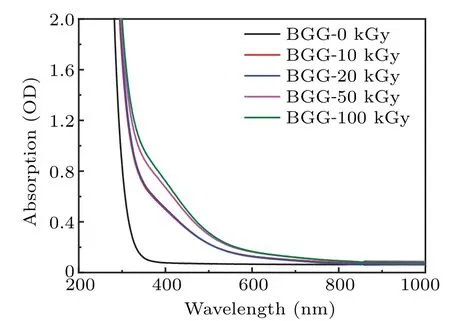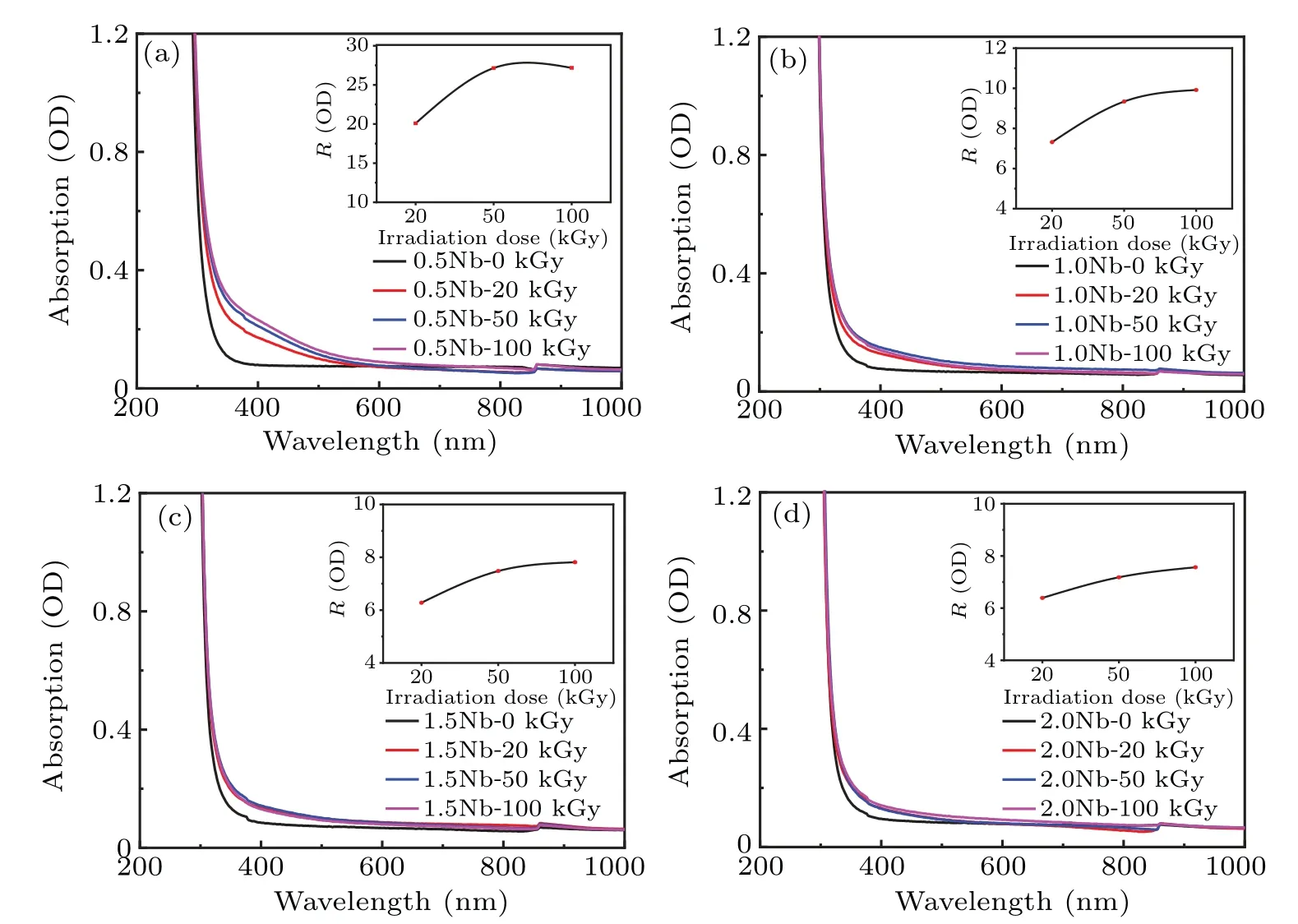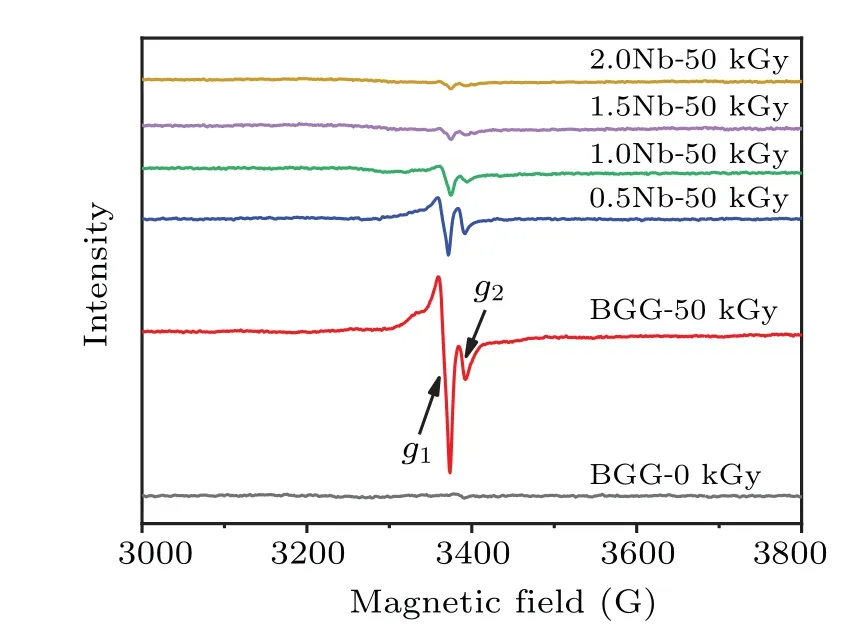Radiation resistance property of barium gallo-germanate glass doped by Nb2O5
Gui-Rong Liu(刘桂榕) Xiao-Dong Chen(陈晓东) Hong-Gang Liu(刘红刚) Yan Wang(王琰)Min Sun(孙敏) Na Yan(闫娜) Qi Qian(钱奇) and Zhong-Min Yang(杨中民)
1State Key Laboratory of Luminescent Materials and Devices and Institute of Optical Communication Materials,South China University of Technology,Guangzhou 510640,China2Guangdong Planning and Designing Institute of Telecommunications Co. LTD,Guangzhou 510630,China3Guangdong Provincial Key Laboratory of Fiber Laser Materials and Applied Techniques,South China University of Technology,Guangzhou 510640,China4Qingyuan Csg New Energy-Saving Materials Co.,LTD,Qingyuan 511650,China
Effects of Nb2O5 dopant on the radiation response of barium gallo-germanate(BGG)glass are studied mainly by electron paramagnetic resonance and absorption spectroscopy. Owing to the Nb5+↔Nb3+ interconversion in doped samples,formations of Ge-related non-bridging oxygen hole center and Ge-related electron center defects after γ-ray irradiation are inhibited. Thereby, Nb2O5 dopant can enhance radiation resistance of BGG glass, and 1.0% Nb2O5 concentration is the best.
Keywords: germanate glass,radiation resistance,Nb2O5 dopant
1. Introduction
Germanate glass, especially barium gallo-germanate(BGG)glass,is an important matrix material for mid-infrared fiber lasers because of its superior transparency for infrared light, high solubility of rare-earth ions, high laser damage threshold, excellent chemical and mechanical properties.[1–7]It has been reported that many pulsed and continuous wave fiber lasers at 2.0µm could be prepared by using Tm3+doped BGG fibers.[8]However, when BGG glass fiber lasers were used in a high-energy ray irradiation environment, such as space applications, high-energy ray would result in darkening appearance of the BGG glass fibers, which is commonly referred to as radiation-induced darkening (RD). The RD in fiber lasers would seriously deteriorate fiber performance and reduce stability and lifetime of these fiber laser devices.[9,10]
It is well known that some metal ions, e.g., iron, manganese, or chromium, doped into glass optical fibers could form some new color centers, causing the additional absorption loss in the optical fibers and making the optical fibers have poorer high-energy ray resistance.[11]However, not all metal ion dopants would reduce anti-radiation performance of glass fibers. Some polyvalent metal ions can absorb charges produced by high-energy ray-induced ionization through valence state conversion, so they would suppress formation of radiation-induced color center defects and improve radiation resistance of glass fibers.[12]After years of research,it has been discovered that some variable metal ions, containing cerium (Ce), strontium (Sm), and antimony (Sb), can strengthen radiation resistance of Yb3+and/or Er3+doping silicate and phosphate glasses for 1.0µm and 1.5µm optical fiber lasers.[12–14]However,there are few studies on the radiation resistance of Tm3+doping BGG glass fibers for 2.0µm optical fiber lasers.
In this paper,RD regularity and characteristic of the BGG glass are investigated. Based on the measurement results of absorption spectroscopy and electron paramagnetic resonance(EPR)spectroscopy of BGG glass,effect of Nb2O5dopant on the BGG glass resistance to theγ-ray radiation is analyzed and discussed.
2. Experiment
The BGG glass samples were synthesized based on the molar composition of (1−x)(15%BaO–15%Ga2O3–70%GeO2)–x%Nb2O5(x=0, 0.5, 1, 1.5, 2) by the conventional melting-quenching technique. The BGG glasses were prepared from high purity reagents(99.99%minimum). For each glass, well-mixed raw materials(50 g)were melted in a corundum crucible at 1300°C for 1 h, meanwhile, the melt was stirred for 1 to 2 min with 3 or 4 times to remove bubbles and stripes. Subsequently, the melt was cast into a preheated steel mold and annealed before they were cooled to room temperature. Lastly, the annealed samples were cut into the size of 20 mm×20 mm×2 mm and polished for subsequentγ-ray irradiation and spectrum testing. According to Archimedes’principle,the density of BGG glass is 4.5081 g/cm3.
The BGG glass samples were exposed to gamma rays using a60Co source with a radioactivity of 4×106Curie at room temperature,and the average dose rate was 41 Gy/min. In order to study the sensitivity of BGG glass to different doses ofγ-ray irradiation, the cumulative doses of the irradiated samples were 10 kGy,20 kGy,50 kGy,and 100 kGy respectively.The samples were irradiated uniformly due to the continuous irradiation. To avoid noticeable radiation-induced absorption degradation during the measurements, the spectra of the glasses were measured within one day afterγ-ray irradiation.
The absorption spectra were tested at room temperature using a Lambda 900UV/VIS/NIS spectrophotometer in the range of 200–1000 nm,and the data acquisition step is 1 nm.EPR measurements were performed at room temperature on a Bruker A300 spectrometer operating at x-band frequencies(υ ~9.45 GHz)with 100 kHz magnetic field modulation,1 G amplitude modulation,and 0.2 mW microwave power.
3. Results and discussion
3.1. Absorption spectrum
Figure 1 shows the absorption spectra of BGG glass samples before and afterγ-ray irradiation with differentγ-ray irradiation doses. In Fig. 1, it is clear thatγ-ray irradiationinduced RD effects in the samples, i.e.,γ-ray irradiation introduced a broad and intense additional absorption band from 320 nm to 700 nm in the BGG glasses. It is also observed that the intensity of the RD continuously increases with increasing irradiation dose in the experimented dose range.

Fig. 1. The absorption spectra of the BGG glasses before and after 20 kGy,50 kGy,100 kGy γ-ray irradiation.
The mechanism of the RD in BGG glasses has been investigated in previous studies.[15–21]It has been verified that the RD effects came from the formation of Ge-related color centers defects afterγ-ray irradiation. Two kinds ofγ-ray inducing defects, Ge-related non-bridging oxygen hole center(Ge-NBOHC)and Ge-related electron center(GEC),were founded in the BGG glass based on thermoluminescence and EPR measurements.[15]
When 2 µm band BGG glass fiber lasers are kept in a radiation environment, RD frequently occurs in glass optical fibers. This has been recognized as a serious issue for the utility of these laser devices because the RD not only gives rise to excessive optical loss in ultraviolet to visible even down to near-infrared region,but also causes a continuous decrease in the performance and stability of these fiber laser system.[9,10]Many studies[12,22–24]have been reported that some ions could suppress the RD effect and enhance the radiation resistance property of glasses. For instance, it has been reported that,in quartz glass, cerium ions could suppress the RD effect caused byγ-ray irradiation,[25]while antimony ions in phosphate glass could mitigate the RD effect.[12]Both cerium and antimony ions have the same characteristics,i.e.,they are variable valence ions,so we choose variable-valency niobium ions to investigate the radiation resistance property of BGG glass.
Figure 2 shows the absorption spectra of BGG glass samples doped with different concentrations of Nb2O5before and afterγ-ray irradiation. In Fig. 2, 0 kGy samples show that the samples are not irradiated byγrays, and 0.5 Nb, 1.0 Nb,1.5 Nb and 2.0 Nb samples designate that the Nb2O5doping molar concentrations in BGG glass samples are(a)0.5%, (b)1.0%, (c)1.5%and(d)2.0%, respectively. From Fig.2(a), it can be seen that theγ-ray irradiation deriving additional absorption in the 0.5%Nb2O5doped sample gradually increases with theγ-ray dose increasing. For clearly displaying the RD degree, the optical absorption of the unirradiated glass was subtracted from that of the irradiated glass:

whereRis the RD degree,Airis the optical absorption of theγ-ray irradiated glass,andAunmeans the optical absorption of the unirradiated glass. The change ofRvalue with increasingγ-ray dose is shown in the inset of Fig.2(a).It is easily realized that, for the 0.5%Nb2O5doped BGG glass samples, 50 kGyγ-ray dose is enough to make glass RD reach saturation.
In Figs.2(b)–2(d), we can also observe that theγ-ray irradiation has induced additional absorption loss in the 1.0%,1.5%, and 2.0% Nb2O5doped samples, and the radiationinduced loss increased slightly with the increase of theγ-ray dose. In the inset of Figs.2(b)–2(d),it is clear that 50 kGyγray dose made those RDs get saturation similarly,so we used 50 kGyγ-ray dose for the later irradiation experiments.
The absorption spectra of Nb2O5doped and undoped BGG glass samples beforeγ-ray irradiation is compared to observe the influence of Nb2O5doping concentration on the absorption performance of BGG glass and shown in Fig.3. It can be seen from Fig. 3 that the Nb2O5doped and undoped BGG glasses have the same absorption spectrum before irradiation,indicating that the Nb2O5doping into the BGG glass could not introduce a new absorption band in the visible to near-infrared region.

Fig. 2. The absorption spectra of the BGG glasses with (a) 0.5%, (b) 1.0%, (c) 1.5% and (d) 2.0% Nb2O5 doping concentration before and after γ-ray irradiation. Insets are the R value as a function of the γ-ray dose.

Fig.3.The absorption spectra of these BGG glasses undoped and doped with different concentrations of Nb2O5 before γ-ray irradiation.

Fig.4.The absorption spectra of these BGG glasses undoped and doped with different concentrations of Nb2O5 after γ-ray irradiation. Inset shows the R value(RD degree)as a function of the Nb2O5 doping concentration.
Figure 4 shows the absorption spectra of Nb2O5doped and undoped BGG glass samples after 50 kGyγ-ray irradiation. From Fig. 4, it is clear that the Nb2O5doping samples showed lower radiation-induced absorption losses in the 260 nm–800 nm region than that of the undoped BGG glass samples. From the inset of Fig. 4, it is easily seen that, as the Nb2O5doping concentration increases, theRvalue (RD degree, as defined in Eq. (1)) gradually decreases. When the Nb2O5doping concentration is greater than 1.0%,theRvalue is unchanged even continuing to increase the Nb2O5concentration. Therefore,it can be concluded that Nb2O5doping effectively increases the glass radiation resistance and the 1.0%Nb2O5doping concentration is enough for inhibiting RD appearance in the BGG glass.
3.2. Electron paramagnetic resonance spectrum and analysis
It has been verified that theγ-ray irradiation inducing additional loss in glass comes from the color center defects produced during theγ-ray irradiation.[16]In order to study the types of color center defects,continuous-wave EPR measurements were performed and the principle of EPR was presented elsewhere.[26]We ground the samples into powder and ensured the same conditions as the tested samples. Figure 5 shows the EPR images of the Nb2O5doped and undoped BGG glass samples before and after 50 kGyγ-ray irradiation. It can be seen that two remarkable EPR signals are detected in the Nb2O5undoped BGG glass afterγ-ray irradiation,while there is no EPR signal in the unirradiated sample. The two EPR signals can be described by a spin Hamiltonian of rhombic symmetry withgvalues which are characterized for hole centers(g1>ge=2.0023) and electron centers (g2 In Fig. 5, it can also be seen that there exist some relatively weaker EPR signals in the 0.5%,1.0%,1.5%,and 2.0%Nb2O5-doped samples undergoingγ-ray irradiation,and as the Nb2O5doping concentration increases,the EPR paramagnetic signal gradually weakens. When the Nb2O5doping concentration is more than 1.0%, the paramagnetic signal intensity becomes very weak, and even though continuing to increase the doping concentration of Nb2O5, the paramagnetic signal intensity has only a little change. Therefore,we can conclude that the presence of Nb2O5significantly reduces the EPR signal intensity, i.e., the formation of Ge-NBOHC and GEC defects induced byγ-ray irradiation in BGG glass can be suppressed by Nb2O5dopant, and 1.0% Nb2O5concentration is sufficient to reduce the radiation-induced absorption loss of BGG glass and to enhance the radiation resistance of BGG glass. Fig.5. The EPR spectra of these BGG glasses undoped and doped with different concentrations of Nb2O5 before and after γ-ray irradiation. According to the previous investigation of the structure of GEC and Ge-NBOHC defects,the formation process of GEC is that the germanium-oxygen tetrahedron captures an electron,as shown by[28] The formation of Ge-NBOHC is as follows:[29] The formation process of Ge-NBOHC is equivalent to the non-bridging oxygen bond of germanium trapping a hole. As confirmed by previous work,[30,31]vanadium-doped glass could suppress the RD effect by capturing the holes or electrons because of the valence transition of vanadium. Niobium ions are similar to vanadium ions,the Nb5+valence ions in the glass could also play a role of electron acceptors to capture the electrons produced during theγ-ray irradiation, and then Nb5+could be converted into Nb4+. The reaction equation is as follows: However, Nb4+is unstable and belongs to an intermediate state. Generally, it would capture another electron to form Nb3+. In the process ofγ-ray irradiation, when Nb3+moved inside the glass structure,it would capture holes again to transform into Nb5+when it encountered holes generated by irradiation, thus forming the mutual conversion of Nb3+↔Nb5+.[12]During the mutual conversion of the two valence states, trapping electron and hole defects would inhibit the formation of Ge-NBOHC and GEC. When the doping concentration of Nb2O5was low, the mutual conversion of Nb3+↔Nb5+could only inhibit the limited formation of Ge-NBOHC and GEC. Therefore, there were still some defects in the glass which would cause small radiation-induced absorption loss of the glass. As the Nb2O5doping concentration increased, the mutual conversion of Nb3+↔Nb5+would inhibit the formation of more defects and reached a balance at last,so that the radiation-induced loss in the irradiated BGG glass was reduced to be very low but could not be eliminated. We have studied the effect of variable valence Nb5+ions on radiation resistance of BGG glass by doping Nb2O5. It is found that the Nb3+↔Nb5+interconversion of the doped sample inhibits the formation of GEC and Ge-NBOHC defects in the irradiation process,thereby inhibits the RD effect of BGG glass and enhances the radiation resistance of BGG glass. The experimental study reveals that the optimal doping concentration of Nb2O5to inhibit the darkening effect of BGG glass is 1.0%. Acknowledgements This work was supported by China National Funds for Guangdong Key Research and Development Program (Grant No. 2018B090904001), the Local Innovative and Research Teams Project of Guangdong Pearl River Talents Program(Grant No.2017BT01X137),Key Laboratory of Laser Device Technology Foundation of China Ordnance Industry Group Co. (Grant No. KLLDT202010), the Key R&D Program of Guangzhou(Grant No.202007020003),and the National Natural Science Foundation of China(Grant No.52002131).



4. Conclusion
- Chinese Physics B的其它文章
- High sensitivity plasmonic temperature sensor based on a side-polished photonic crystal fiber
- Digital synthesis of programmable photonic integrated circuits
- Non-Rayleigh photon statistics of superbunching pseudothermal light
- Refractive index sensing of double Fano resonance excited by nano-cube array coupled with multilayer all-dielectric film
- A novel polarization converter based on the band-stop frequency selective surface
- Effects of pulse energy ratios on plasma characteristics of dual-pulse fiber-optic laser-induced breakdown spectroscopy

